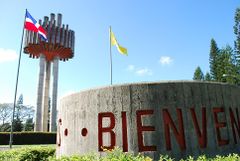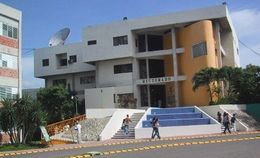Santiago de los Caballeros
| Santiago de los Caballeros | |
|---|---|
|
|
|
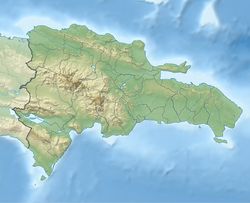 Santiago de los Caballeros
|
|
| Coordinates: | |
| Country | |
| Province | Santiago Province |
| Municipality | Santiago de los Caballeros |
| Founded | 1495 |
| Area | |
| - Total | 524.03 km2 (202.3 sq mi) |
| Elevation[1] | 175 m (574 ft) |
| Population (2008)[2] | |
| - Total | 1,329,091 |
| - Density | 3,695.8/km2 (9,572.1/sq mi) |
| - Metro | 1,936,721 |
| - Demonym | Santiaguero(a) |
| Municipal districts | 5 |
| Website | Portal del ciudadano |
Santiago de los Caballeros (English: Saint James of the Gentlemen) is a city in the Dominican Republic. Founded in 1495 during the first wave of European colonization of the New World, today Santiago (the first "Santiago" of the Americas) is the second largest Metropolis in the Dominican Republic, located in the North-central region of the Republic known as Cibao valley.[3] This city is the capital of Santiago Province.
Contents |
History
The original colony was in the city of Jacagua, which was founded in 1495, but when it was destroyed by an earthquake, it was moved to its present location in 1506. It was devastated by another earthquake in 1562. Santiago de los Caballeros has sometimes been the capital of the country, and was an important strategic city in the Dominican War of Independence in 1844.
The name of the city, Saint James of the Gentlemen, makes allusion to the gentlemen that actually founded the city. Sometimes the city is even called Santiago de los 30 Caballeros (English: Saint James of the 30 Gentlemen) since the city was founded by 30 gentlemen who signed the city incorporation.
Geography
Santiago de los Caballeros is located on a hilly terrain in the middle of the Cibao Valley in the Central Region of the Dominican Republic, one of the most fertile lands found in the island. The Yaque del Norte River passes by Santiago which is in between the Cordillera Central and the Cordillera Septentrional, two of the three major mountain ranges on the island of Hispaniola, forming the Cibao Valley.
Climate
The average temperature varies little in the city, because the tropical trade winds help mitigate the heat and humidity throughout the year. December and January are the coolest months and July and August are the warmest. Santiago and the rest of the country are in the Caribbean and have a tropical climate, which, when coupled with the city's altitude, 183 meters above sea level, causes cloudy conditions to persist through much of the year. The city and the country are also apart of the Hurricane belt, yet Santiago is more sheltered than other parts of the country due to its location in the Cibao Vally.
| Santiago, Dominican Republic | ||||||||||||||||||||||||||||||||||||||||||||||||||||||||||||
|---|---|---|---|---|---|---|---|---|---|---|---|---|---|---|---|---|---|---|---|---|---|---|---|---|---|---|---|---|---|---|---|---|---|---|---|---|---|---|---|---|---|---|---|---|---|---|---|---|---|---|---|---|---|---|---|---|---|---|---|---|
| Climate chart () | ||||||||||||||||||||||||||||||||||||||||||||||||||||||||||||
|
||||||||||||||||||||||||||||||||||||||||||||||||||||||||||||
|
||||||||||||||||||||||||||||||||||||||||||||||||||||||||||||
Economy
The city of Santiago, as most of the Cibao region, is largely dependent on the fertile lands of the region. This makes Santiago de los Caballeros an important region for farming and livestock. The city has been recently changing into a predominantly service provider economy. This sector has grown a lot in the recent years making it ideal for greater expansion. It should be noted that Santiago is the 2nd largest city in the Dominican Republic after Santo Domingo and concurrently produces the 2nd highest percentage of the nations GDP. Telecommunications, such as; wireless phones, cable service, internet service and other services are important for the local economy. Tourism too, accounts for an important portion of the city's economy.
Growth and Development
Like Santo Domingo, Santiago has recently experienced an era of rapid growth and development. It has become a city of great importance for the nation and the region's development. Santiago like any other fast growing city is faced with numerous problems including irregular electricity service and insufficient potable water. The approximate population of Santiago is about 1,936,721 inhabitants. The fastest growing neighborhood in the city of Santiago is the traditionally upper middle class neighborhood La Trinitaria.
Shopping in Santiago
- Bella Terra Mall
- Colinas Mall
- El Encanto
- El Mercado del Cibao
- El Super Pola
- La Opera
- La Sirena
- Plaza Internacional
- Price Smart
- Calle del Sol
- JUMBO
- Multi Centro La Sirena
Santiago`s Night Life
- Mr. Hooka
- KuKaraMakara
- Montezuma Bar and Grill
- Sushi Ya!
- Camus Glam Club
- Vitra lounge
- Shisha
- Privilege
Arts and Culture
Architecture
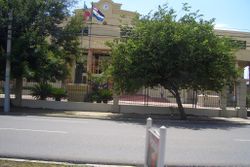
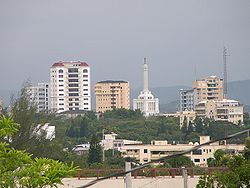
Catedral de Santiago: The Cathedral of Santiago was built in 1895 by Onofre de Lora, an architect native to the city. [1]
Hermanos Patiño Bridge:
The Hermanos Patiño Bridge is both the largest and oldest bridge in the city connecting the North and South sides of the city of Santiago. Its construction was started by Rafael Leonidas Trujillo and inaugurated in 1962, one year after his death. The Bridge is named after the five (not two) brothers that died in an effort to end Trujillo's regime and dictatorship in the Dominican Republic in the mid 20th Century. The anti-Trujillo legacy of the Patiño family did not began with the brothers, but with their father who was killed in 1931 in the first anti-Trujillo insurrection in the Dominican Republic.[2]
Monument to the Heroes of Restoration: On a hill overlooking Santiago is a 67 meters (220 ft) high marble monument. Construction of the monument began in 1944 on the orders of then-dictator Rafael Trujillo. He named it the "Monument of the Peace of Trujillo". Trujillo was assassinated in 1961, after which the monument was renamed the "Monument to the Heroes of the Restoration", in remembrance of the Independence Restoration War of 1863, in which the Dominican Republic regained its independence from Spain. [3]
Sites of Interest
- Estadio Cibao
- Gran Arena del Cibao Dr. Oscar Gobaira
- Monumento de Santiago
- Centro Leon
- La Trinitaria
- Colinas Mall
- Plaza Internacional
- Centro Español
- Country Club Santiago
Museums

There are some interesting museums in Santiago that show the culture of this northern city. Some of them are:
- Museo Folklórico Yoryi Morel : This Museum is located in the Historic City Center on Restauración Street. It exhibits Santiago's Carnival culture, and displays some interesting garments worn by lechones of Santiago Province in the Carnival, as well as those worn in other provinces. The museum is named after noted Santiago painter Yoryi Morel.
- Museo del Tabaco: or The Tobacco Museum is located in the Town Center. Different manufacturing methods as well as the effect of the tobacco plantations along the city's history.
- Museo Histórico Fortaleza San Luis: or Historic San Luis Fort Museum is located in front of the Yaque del Norte River, Southwestern Santiago. It previously served as a municipal prison. [4]
- Museo de los Héroes de la Restauración: or Restoration Heroes Museum (under Construction) is located in The Santiago Monument. It displays the Restoration War pictures from the 1863–1865 battles between the Dominican Government and the Spanish army. [5]
- Centro León: This Museum is located at 27 de Febrero Avenue. It displays elements of the Caribbean and Dominican cultures, Natural Dominican History, Native Indian Evolution and Culture. Also, it periodically hosts different art exhibitions of Dominican and international artists. The museum is under the authority of the León Jimenez Foundation (owner of the Cervecería Nacional Dominicana as well as the Industria de Tabaco León Jimenez). [6]
Sports
As much as the rest of the nation, Santiago residents enjoy baseball and look forward to the Dominican winter season with the local team being the Aguilas Cibaeñas. [7]. Besides baseball, basketball is also played at a professional level in the city of Santiago. The institution in charge of organizing these events is the Asociación de Baloncesto de Santiago de los Treinta Caballeros (ABASACA) [8]
Santiago's major baseball and basketball teams are the Aguilas Cibaeñas and Los Metros de Santiago.
The Female Volleyball Team have claimed two bronze medals[4] in the professional Dominican Volleyball League.
Education
Santiago is home of several universities including Pontificia Universidad Católica Madre y Maestra (PUCMM) and Universidad Tecnológica de Santiago (UTESA). Other higher learning institutions present in Santiago are: Universidad Organización & Método (O&M), Universidad Abierta para Adultos (UAPA), Universidad Nacional Evangélica and one regional campus belonging to the Universidad Autónoma de Santo Domingo
Transportation
Carros Públicos: Santiago does not have an efficient form of transportation, there is however “Carros Públicos” (conchos) and private and independent bus owners who form their own routes according to demands.
Inter-City Bus Transportation: The city has private bus transportation to other important cities. Bus companies include Metro, Caribe Tours, Transporte Espinal, Aetra Bus.
Highways: The Autopista Juan Pablo Duarte Officially known as DR-1 passes by the city center and connects the city directly to Santo Domingo. Other minor highways connect the city to Puerto Plata, Samana, and the northwestern region of the country. Overall, Santiago has a fine connection through highways to the rest of the country.
Airports:
- The Cibao International Airport serves mostly Dominicans living in the United States and other Caribbean islands like Cuba, Turks and Caicos Islands, Puerto Rico and Panama. [9].
- The former airport of the city was the Santiago Municipal Airport, a regional airport that has been closed since March 2002. It served destinations such as San Juan, Port Au Prince, Miami and Santo Domingo with regular services.
Proposed Rail System: The construction of a light metro rail is in the planning stage. It's scheduled to be started by the summer of 2009. Financing is to be by a private firm, the State Rail System of Spain (FEVE). The Light rail system will connect the City center to the Airport and shorten the amount of time of trips.
Health
Facilities include Cabral y Baez, Clínica Corominas, and Union Médica, and Hospital Metropolitano De Santiago which offer their services in the city.
New Projects
- Gran Cibao Hotel – 11 stories high, it is the largest hotel in the Cibao region.
- Light Rail in Santiago – A Light Rail development in the city's metro area has been proposed. If completed it will be the second city In the nation to have a mass transit system and would be 3.4 miles longer than the Metro of Santo Domingo. The Light Rail will have 12 stops, its route will be from the Cemetery to the Airport. Construction was scheduled to begin in October 2007 but currently the project has been delayed and on Hold.
- Electric “Highway” from Santo Domingo – Santiago's power comes from Puerto Plata, but the government commenced the building of the Electric “Highway” that will feed Santiago electric energy from Santo Domingo's generators. construction started in February 2007.
- Central Park of Santiago – The Central Park of Santiago is projected to be constructed on the land of the now defunct old Santiago Municipal Airport that now lodges the regional seat of the National Police and the offices of the Association for Development.
The industrialists of Santiago have defended the project since it is considered to be a solution to the lack of green spaces suitable for relaxation in the city. Nevertheless it has been argued that the granting of contracts for the different phases from this project violate the frame of transparency and legality. In the Strategic Plan of Santiago it is indicated that the construction of the Metropolitan Park would increase the Santiagos green area from its currently 1.1% to 4%.
- Santiago Inteligente and Santiago Massive Retraining Program (SMART)-An initiative launched recently by the Center for Exports and Investment of the Dominican Republic (CEI-RD), headed by Eddy Martínez Manzueta and the Plan Estrategico de Santiago seeking to foster the new regional economic development and branding strategy and the promotion of Santiago as a knowledge-based production center in both conventional and emerging sectors, including Health Tourism, ITES-BPO, biotechnology and agro-business, as well as High-value manufacturing and Fashion (textiles and apparel, footwear), among others. The initiative focuses on education and training activities, new architectural designs and development projects as well as an international marketing campaign that will help position Santiago as a unique region for R&D, innovation, and world class products and supreme quality workforce.
Hotels
Although it is not a major touristic point in the Dominican Republic (known mostly for its beach based tourism), there are multiple hotels currently operating in the city. Some include:
- Hodelpa Garden Court: (5 stars) It is located in Duarte Highway in Santiago-La Vega route. It is a five star hotel and it is near Cibao International Airport. Before it was acquired by Hoteles del Pais(HODELPA), this hotel was known as the 4th of the Courtyard Marriot international hotels in all of the globe, in comfort and pleasure. Now it's owned by HODELPA and its old name Courtyard Marriot Santiago was changed to Garden Court.
- Hodelpa Gran Almirante: (5 Stars) Is located in Estrella Sadhala Avenue. It hosts one of the few casinos in the city and is used for conventions and meetings.
- Hotel Gran Cibao: (5 Stars) It is located in the Duarte Highway. To be opened soon. It is one of the largest hotels ever built in Santiago. It is believed that this hotel will increase tourism in this city, as well as other sectors of the city's economy due to the creation of direct and indirect employment.
- Hodelpa Centro Plaza: (4 Stars) This hotel has a Casino. It is located in Calle San Luis, in the center of the city, so it is easy for visitors to experience the historic sites of the city and it is near some of the above mentioned museums.

- Hotel Matum: (4 Stars) It is located in Las Carreras Avenue in front of the Gran Teatro del Cibao. It is a four star hotel with a Casino operating in its facilities.
Recreational Places
Some of the recreational places found in Santiago are:

- Centro Español: located in the Panamericana Avenue, this place is heavily frequented during the summer by Santiago's local population and tourists. Many activities take place in it, such as sports; swimming, basketball, baseball, softball, football, golf, table games, and children summer camps. They also host parties with famous Dominican and international artists. Its access is restricted to registered members only. [10]
- Gurabito Country Club: Another popular club located in Panamericana Avenue, it's another recreational center. They have sports activities, such as baseball and basketball. Parties with Dominican artist take place periodically in this club as well as some pool parties with Dominicans singers. Access is restricted to members only.Website
- Kaskada Agua Park: Located in Panamericana Avenue too, is a water theme park. This locale is open to the general public.
Notable residents of Santiago de los Caballeros
- Joaquín Balaguer – Dominican President and a protégé of Rafael Trujillo
- Salvador Jorge Blanco – Dominican President, lawyer and a writer
- José Cabrera – MLB player for the Houston Astros, Atlanta Braves and the Milwaukee Brewers
- Aisha Syed Castro – violinist
- Amelia Vega – Miss Universe 2003
- Martha Heredia – Latin American Idol
- Fernando Cabrera (writer) – Dominican poet, visual artist and song writer
- Rafael Filiberto Bonnelly – Dominican President, lawyer, scholar and diplomat
- Francisco Caamaño – Dominican soldier and politician
- Antonio Guzmán Fernández – Dominican President
- José Lima – Dominican Baseball player
- Ñico Lora – father of Merengue
- Hipólito Mejía – Dominican President
- Julián Tavárez – Dominican Baseball player
- Angel Berroa – Dominican baseball player
- Luis Polonia – Dominican baseball player
- Tony Peña Jr. – Dominican baseball player
- Jose Reyes – Dominican baseball player for the New York Mets
- Jose E Devarez – Well known journalist
- Jhonny Peralta – Dominican baseball
- Joaquin Benoit – Dominican baseball player
- Luis Vargas – Dominican musician of Bachata
- Janira Bonilla – Dominican writer
- Rafael Belliard-Dominican baseball player and cousin of Washington Nationals 2B Ronnie Belliard
- Melky Cabrera – Dominican baseball player
- Krisspy – Dominican musician of Merengue
- Manny Perez – actor
- Carlos Almanzar – Dominican baseball player
- Carlos Villanueva – MLB player for the Milwaukee Brewers
- Bill Castro-MLB player for the Milwaukee Brewers, New York Yankees, and the Kansas City Royals; pitching coach of the Milwaukee Brewers
- Carlos Gomez – Dominican Baseball Player for the Minnesota Twins
- Douglas Gonzalez- Computer Magnate, Information Systems Professional, US NAVY Veteran (USS COLE DDG-67 Plankowner). Security Fraud Expert.[5][6][7][8]
- Leonardo Cruz – Dominican Boxer
- Jeen Camilo – Computer Magnate, President and CEO of Look Inc.
- Eddy Herrera – Famous Merengue singer
- Patricia Gomez – Super Model
- Wily Mo Pena – Baseball Player
- Bernie Castro – Baseball Player
- Winston Llenas – Former Dominican Baseball Player
- Miguel Batista – Baseball Player and Writer for the Seattle Mariners
- Andy Peña – Dominican Bachata Singer
- Luis Pujols – Former Baseball player
- Amelia Vega – Miss Universe 2003
- Apostol. Dr. Lucas Rojas Villavizar – Recognized Evangelist & Pastor of Congregacion Cristiana Inc.
- Felix Jose – Former Baseball Player
- Alberto Alburquerque – Dominican Baseball Player
- Victor Diaz – Dominican Baseball Player for the Baltimore Orioles
- Franquelis Osoria – Dominican baseball player
- Alfredo Simon – Dominican Baseball Player for the Baltimore Orioles
- Rafael Furcal -Dominican baseball player for the Los Angeles Dodgers
- Francisco Pena – Dominican baseball player for the New York Mets Son of Tony Pena and brother of Tony Pena Jr.
- Ramon Pena – Former baseball relief pitcher and member of the famous baseball Pena family*
- Leo Garcia – Former baseball player
- Robinson Checo – Former Baseball Player
- Rudy Hernandez – Former Baseball Player
- Luis Silverio – Former Baseball Player who is now a coach
- Carlos Triunfel – Baseball for the Seattle Mariners organization
- Hipólito Pichardo – Former Baseball of the Kansas City Royals, Boston Red Sox and the Houston Astros
Sister cities
Santiago has twinning agreements with the following sister cities:
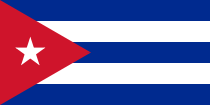 La Habana (Cuba)
La Habana (Cuba) New York City (United States)
New York City (United States)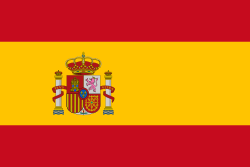 Santiago de Compostela (Spain)
Santiago de Compostela (Spain)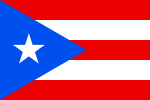 San Juan (Puerto Rico)
San Juan (Puerto Rico)
External links
- Archivo Histórico de Santiago
- Carnival Mask of Dominican Republic
- Pontifícia Universidad Católica Madre y Maestra
- La Universidad Tecnológica de Santiago
- Centro Leon
- Santiago
- Source Weather Santiago
Photo gallery
 Houses in Santiago Old Historic Center |
 Nuestra Señora de la Altagracia Catholic Church |
 Performing Arts Center |
 A view of the Northeastern section of Santiago |
References
- ↑ De la Fuente, Santiago (1976) (in Spanish). Geografía Dominicana. Santo Domingo, Dominican Republic: Editora Colegial Quisqueyana.
- ↑ http://encarta.msn.com/encyclopedia_761567940/Santiago_(Dominican_Republic).html
- ↑ Staff writers (2007-08-22). "Dominican Republic Central Regigon". Ministry of Tourism. http://www.godominicanrepublic.com/main.asp?xmlpath=/DominicanRepublic/Regions/Central/santiago_en.xml&Lang=. Retrieved 2007-08-22.
- ↑ http://www.fedovoli.org/ListItem.aspx?ListId=387
- ↑ http://www.salemnews.com/pubiz/local_story_308224711.html?keyword=secondarystory
- ↑ http://www.cutimes.com/Issues/2008/October%2029,%202008/Pages/CUNA-School-Graduates-11.aspx
- ↑ http://training.cuna.org/download/SCSWA08.pdf
- ↑ http://www.linkedin.com/pub/douglas-gonzalez/4/3aa/656
|
||||||||
|
|||||||
|
|||||
